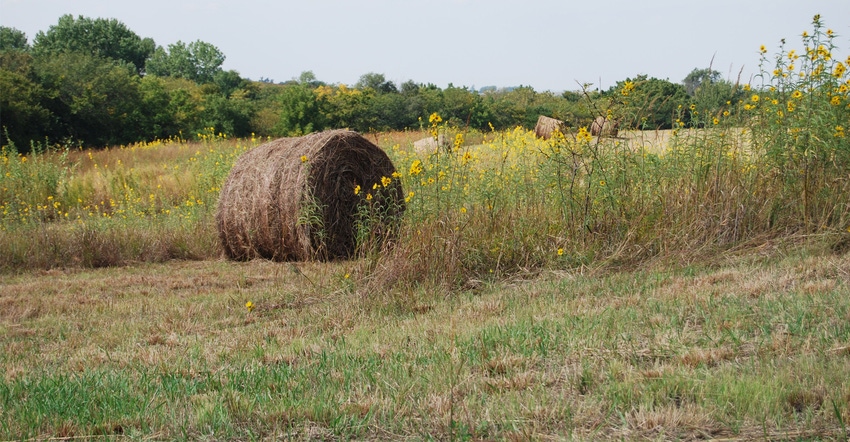January 1, 2018

True to their name, perennials are a recurring thread in Resilient Ag Landscapes columns — and for good reason. Perennials offer their share of soil health benefits, including improving organic matter, reducing soil erosion and improving water infiltration. That's largely thanks to the amount of biomass produced above and belowground with perennial grasses.
However, when seeding perennials, Rob Mitchell, research agronomist at the Wheat, Sorghum and Forage Research Unit at USDA Agricultural Research Service in Lincoln, says, "All cultivars are not created equally. One of the biggest impacts we can make when we're seeding native perennial warm-season grasses especially on marginal ground, it matters what species we select and it matters what cultivar of species we select.”
Over the last decade, ARS in Lincoln has released several newer varieties of native warm-season perennials.
One of the most notable examples is in Bonanza big bluestem, released in 2006, which saw a 16% increase in average daily gain (ADG) over the base population when fed to cattle. Bonanza was developed from the parent cultivar, Pawnee, by retired ARS researcher Ken Vogel, who selected for higher yield and digestibility from three generations of Pawnee big bluestem.
Bonanza big bluestem has a 1.4% increase in yield and a 1% increase in digestibility over Pawnee during the vegetative stage. Averaged over three years of grazing at the Eastern Nebraska Research and Extension Center near Mead, yearling steers grazing Bonanza pastures had 16% greater ADG than cattle grazing Pawnee pastures. Bonanza pastures produced 14% more pounds of gain per acre than Pawnee pastures.
"A lot of times cattle are limited by intake. If they can consume forages of higher digestibility, they have higher likelihood of converting it to muscle mass," Mitchell says. "Essentially by grabbing a different bag of seed, you can increase your ADG by as much as 16%."
Vogel used a similar process to create Warrior and Scout, two varieties of indiangrass with increased yield and digestibility. Scout has a 1% increase in in vitro dry matter digestibility (IVDMD) over its parent population, Nebraska 54, while animal performance is about 20 kilograms of body weight gain per hectare (about 17.84 pounds per acre) over its parent population. Meanwhile, Warrior has about 41 kilograms of body weight gain per hectare (36.57 pounds per acre) over its parent population.
Scout also yields about 1.2 megagrams per hectare more biomass above ground than its parent population — about 1,070 pounds more biomass per acre.
But research in perennial cultivars hasn't just involved grasses for forage. It also includes switchgrass for bioenergy. Most recently, Vogel developed Liberty switchgrass for biomass production. Compared to other varieties in eastern Nebraska, it shows an average of 50% increase in biomass production.
"The bioenergy switchgrass types are lowland ecotypes, from more of a southern origin," Mitchell says. "We've developed bioenergy specific switchgrass of the lowland ecotype that's more productive, will get 8 to 10 feet tall and will produce typically anywhere from 5 to 7 tons of biomass per acre in a single harvest."
Keith Glewen, Nebraska Extension educator, grew Liberty switchgrass for bioenergy production at the Eastern Nebraska Research and Extension Center for four years.
"From an agronomic perspective it's not difficult to grow. Establishment is one of the big challenges, but we have tools today that make establishment easier. It takes the right kind of drill, the right kind of seedbed, and the use of herbicide for establishment," Glewen says. "When compared to other perennial native grasses early on the growing season, you might think this isn't going to stack up well. But at the end of the growing season, it outperforms in biomass quantity."
However, one of the challenges is finding an available market for switchgrass. While cellulosic ethanol production isn't currently an easily-accessible option for switchgrass producers in eastern Nebraska, Glewen adds growers can still bale it and mix it with distillers grain to feed to cattle.
And like many perennials, bioenergy switchgrass offers a number of soil health benefits. Mitchell notes greater biomass production aboveground equates to greater biomass production belowground.
"One thing that's been evident with planting switchgrass for bioenergy on marginally productive cropland is that we're seeing over a long term about a ton of soil organic carbon per acre per year increase over the long term," Mitchell says. "That's pretty significant carbon storage — one of the reasons being that these plants are productive, but also deep-rooted. They're able to put roots down 8 to 10 feet below the soil surface, not only giving an opportunity to harvest water and nutrients from a larger soil volume, but also putting organic matter deeper into the soil profile."
You May Also Like




